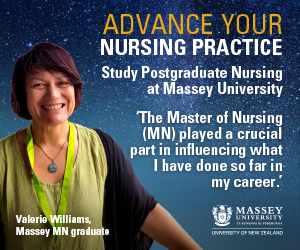Most district health boards should be able to implement the safe staffing CCDM system for nurses “much, much faster” than the 2021 deadline, says DHBs spokesperson Jim Green.
Talking to Nursing Review following the settling of the DHB NZNO agreement this week he said he was confident that the new deal and that CCDM (Care Capacity Demand Management) would deliver safe staffing for nurses.
Green said it was already doing so in some DHBs further down the track with the safe staffing tools but added it wasn’t a simple process.
He said a ward chronically understaffed would show up under CCDM and the new deal’s $38m for immediate extra staffing would be used to start addressing the most chronic under-staffing pressure points. “It may be just one extra nurse or it may be just one extra health care assistant (HCA) that is needed.” Green said while people had focused on the $38m being the equivalent of employing 500 nurses the purpose of the funding was to relieve immediate pressure areas and may be used to employ extra HCAs not just nurses.
Green, who served on the original Safe Staffing Healthy Workplace Inquiry over a decade ago, also emphasised that safe staffing was “not just a numbers game” but ensuring the right skill mix, support people and “all the things that go together to make good care”.
“In this atmosphere – where nurses feel unable to provide the right care that they want to provide to people on a day-to-day basis – to add in additional pressure like more graduate in the workplace may be counter-productive, so we have to be very careful about that as well,” said Green. So DHBs taking on new graduates would have to ensure first that the novice nurses had the support to do the job expected of them and the nurses around them we able to see an improvement (in care they can offer). “We don’t want to go backwards.”
The latest DHB workforce statistics for March 2018 show that the nursing workforce had grown in the previous 12 months by nearly 800 nurses (3.6%) to 22,470 fulltime equivalents (FTEs) or 27,734 nurses. Which was up on the about 2 per cent annual increase in nursing numbers averaged by DHBs between 2007-2014.
Green said part of that growth was due to more DHBs starting to implement CCDM and employing more nurses where calculations showed understaffing to meet patient need and demand. “We’ve agreed there needs to be more (growth in nurses) and we need to utilise the really good technology we’ve got in CCDM to decide how many more nurses we need and where we need to place them.”
He said the decisions on how to spend the immediate $38m would be made through local CCDM councils in DHBs which already have them but otherwise through agreement on where the biggest pressures and strains currently are for nursing in that DHB.
“What it seems to me that nurses are saying is ‘when I was on this shift on this ward, on this I had to run, I didn’t have a meal break and couldn’t do all the things I needed to do and I left this shift late feeling I could and should have done more’ – those are the areas we need to be looking at,” said Green.
CCDM has been slow but will speed up now
Green believed that the new NZNO DHB deal meant CCDM was now set up to finally be implemented nationwide.
“I’m not an apologist for the fact that CCDM has been in the MECAs for a long time – and it hasn’t been consistently implemented in a good way across all the DHBs – I’m certainly not an apologist for that.
“I’m also mindful that it is not something as simple as falling off a log…” said Green. He said he was reminded this week by a director of nursing yesterday about all the foundation parts needed to be put together to get CCDM underway.
“It is a long and difficult process. It requires quite a change of behaviour on the part of so many people.”
There are 14 DHBs at various stages of actively implementing CCDM who had CCDM councils working with the Safe Staffing Healthy Workplaces Unit on their CCDM projects with two more Wairarapa and West Coast now also starting implementation.
The CCDM system was developed using the validated patient acuity software TrendCare which, when the MECA negotiations started last year, only 16 of the 20 DHBs had in place.
But during the DHB NZNO negotiations – which from late last year included a commitment for all DHBs to fully implement CCDM by mid 2021 – three of the other DHBs have come on board with Lakes now implementing TrendCare, Counties Manukau now developing a business case for TrendCare and Canterbury developing a business case for the ‘appropriate’ acuity software, which is anticipated to be TrendCare. The fourth, Waikato, is currently still seeking to implement CCDM using a different acuity tool.
Green said it was estimated that it required around three years to fully implement the programme which was why the deadline had been set for 2021 to allow time for the late starting DHBs.
“However I don’t see that we (the other DHBs) won’t be making progress much, much faster – with greater degrees of progress already at many DHBs.” He believed the other DHBs would also catch up quickly because of the greater resources going into the Safe Staffing Healthy Workforce (SSHW) Unit (an extra $750,000) and to DHBs ($10m for extra 2FTE per 600 nursing FTE) dedicated to implementing CCDM.
Employing all new graduates
Green said work on exploring options for employing all graduate nurses began “before the ink had dried” on the safe staffing Accord as the accord agreement required a report to be with the Minister of Health by the end of November.
He said initial talks had already been held with some nursing leaders about who needed to be around the table to develop the report which would build on the current NETP (nurse entry to practice) programme and the Nursing ACE job matching process and statistics. “My view is that we should easily be able to achieve the November timeframe with that report.”
He said he would not pre-suppose the outcome of the report and what it would recommend.
“It’s not just a case of recruiting people,” said Green, as adding additional pressures on already stretched nurse to support new graduates might be counter-productive. “We have to ensure that the nurses who are providing preceptorship are supported to be able to do that. So therefore the nurses coming into the environment are able to be supported as well.”
A really good deal
He hopes that nurses will come to see the new agreement “for what it is – a really good deal”.
“Nurses are really concerned about patients and their safety and their care. Nurses have through this agreement have been able to achieve some really significant – almost once in every 10 to 20 year – changes.”
He believed it was time now to move on, be positive about the changes underway and be supportive of the efforts of nursing leaders in “the thick of it every day making decisions and doing things to make sure that people can get good care.”
More information about CCDM here.

























